
Most Common Utah Weeds
-
 Weeds have been a problem ever since mankind decided to grow one plant instead of another, which is the very definition of a weed: a plant that grows where you don’t want it to grow. There are many reasons a plant can be a weed: it could be interfering with natural waterways, stealing water and sunlight from food crops, or just making our lawn look…weedy. The State of Utah has declared certain plants as noxious weeds--non-native plants that cause a large amount of damage to croplands, pastures, forests, waterways, and even residential yards. Here are three of the most problematic weeds in Utah landscapes and how to control them.
Weeds have been a problem ever since mankind decided to grow one plant instead of another, which is the very definition of a weed: a plant that grows where you don’t want it to grow. There are many reasons a plant can be a weed: it could be interfering with natural waterways, stealing water and sunlight from food crops, or just making our lawn look…weedy. The State of Utah has declared certain plants as noxious weeds--non-native plants that cause a large amount of damage to croplands, pastures, forests, waterways, and even residential yards. Here are three of the most problematic weeds in Utah landscapes and how to control them.
#1 – Field Bindweed (aka Morning Glory)
Convolvulus arvensis
Morning Glory works its way into the plants we love, growing inconspicuously through shrubs, lawns and perennials, twining along branches and stems until its leaves emerge and bloom with pinkish-white flowers, suddenly letting you know you’re in the trouble. When you try to yank it up, you’re rewarded with only the tiniest bit of root for your effort.
As long as there is a piece of Morning Glory root in the ground the weed can regrow. It has evolved brittle roots that break easily to leave as much root as possible in the soil. Controlling bindweed by pulling it is not effective and tilling can make the problem worse. The best approach is to kill the roots. Many systemic broadleaf weed killers are effective, but timing is important. After the first frost when the plant is pulling energy from its leaves down to the roots is the best time to spray. The weed killer chemicals will be pulled down along with the plant nutrients and will cause the greatest damage. Keep your wanted plants and lawn healthy to create competition with the Morning Glory.
-

-
#2- Crabgrass
Digitaria sanguinalis
Crabgrass is a well-known offender, so much so that any grassy weed in a lawn is assumed to be crabgrass. To make sure the weed you are dealing with is, in fact, crabgrass, look for telltale signs like stems that lay along the ground and red seed heads with five stalks like a “bloody hand,” which is the meaning of crabgrass’s botanical name Digitaria sanguinalis.
Crabgrass loves a struggling lawn, so keeping your lawn healthy is your first line of defense. Crabgrass grows from and spreads prolifically by seed each year. Any control effort should include a pre-emergent herbicide that kills seedlings as they come up.
-

-
#3 – Dandelion
Taraxacum officinale
This menace to lawns is found throughout the world. Its seeds are sent out with little umbrellas to catch the wind and spread to new locations. The real key to its survival is a large taproot that, if not fully removed, will grow back.
It is possible to control dandelions by manual removal only if the whole root is removed. They can also be controlled with systemic herbicides that will transfer poison to the roots. The dandelion is a culinary crop in some parts of the world, so if you can’t beat them, eat them.
-

-


